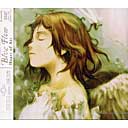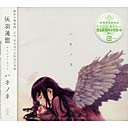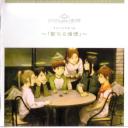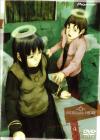 |
||
|
Haibane Renmei in Review
A girl falls from the sky. A crow tries to stop her fall, but fails and is blown away. Soon after this, she hatches from a large cocoon, and is quickly surrounded by girls with wings and halos. They give her a halo of her own and the name Rakka, meaning falling, after her dream. One of them, Reki, stays behind to care for Rakka as she grows her wings that night.
Thus begins Haibane Renmei, the work of ABe yoshitoshi (Serial Experiments: Lain, NieA_7, Texhnolyze). This thirteen episode series is based on his doujin Old Home no Haibane-tachi, with ABe providing the screenplay as well.
I once saw ABe described as "being able to make the extraordinary ordinary", and he does so again with great style. Although the setting is fitting for a fantasy story, ABe grounds everything. It all works, it all feels real. The city of Glie, the location of the show, manages to feel like it would be a wonderful place to visit, if only it were allowed.
Things start with much of the feel of a slice-of-life show. We see the haibane in their everyday activities, with only some foreshadowing proclaiming there's a larger story building. This part is carried strictly by the strength of the characters, as in any slice-of-life show. All of the major cast show well developed personalities, each distinct and very real. Even the minor characters manage to seem like fully developed leads that have just stopped by from their own story for a moment.
Once the main plot kicks in things get much more intense. Every episode builds on the previous episodes, leading to a wonderful climax. Rakka goes through the world of Glie, not so much discovering the mysteries of the haibane as experiencing them. There's a very spiritual tale in these thirteen episodes, one that will resonate with anyone who's experienced the melancholy side of life. If you're looking for a break from incessant cuteness, manic action, mecha fights, and crack-smoke comedy, you can't go wrong with Haibane Renmei.
There aren't many anime that can be readily compared to Haibane Renmei. Perhaps the closest in mood is Yokohama Kaidashi Kikou, which has not been released in the US. The only other comparison is to the works of Hayao Miyazaki. A dark, introspective Miyazaki, granted, but the artwork, setting, and characters manage to capture much of the same feel.
Although ABe did not do the artwork or character designs for the anime himself, RADIX has managed to capture his style to a surprising degree. The haibane's wings are a lighter shade of gray than in the doujins, but that's the only really noticeable change. The backgrounds are simply wonderful, whether it's the rolling hills covered with wind generators or the old stone buildings of the city.
The animation is good, but this isn't an action series. The story is very dialogue driven, and for the most part truly high frame rates aren't required. Pans, stills and zooms are used, but all in ways which fit the story. Combined with a widescreen anamorphic encoding, there's very, very little to complain about here.
The music is provided by Kou Otani and Heart of Air. Mostly classical style pieces, they fit the ambiance created by the story and the artwork very well. They are also used very well, adding impact to already strong scenes. They also have the uncommon ability to use silence to good effect. The ending theme is a wistful vocal that does a good job of capturing the essence of the show.
Geneon (formerly Pioneer Entertainment Inc.) has made
a solid R1 release, although there is a minor disappointment I want
to address. This was the Haibane Hakusho, the "whitepaper"
booklets included with the R2 release. Geneon, whether due to license
restrictions or to cost, did not translate all of these. The character
profiles included with disc one were nice, but the Hakusho included
a large amount of other information that most of the US audience will
now likely never see.
|
||
|
Copyright 2003 - wraith@ssw.net
Images Copyright Pioneer and/or yoshitoshi ABe unless otherwise noted |





































